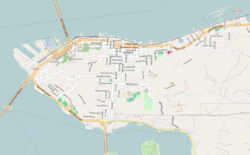
Astoria is a port city and the seat of Clatsop County, Oregon, United States. Founded in 1811, Astoria is the oldest city in the state and was the first permanent American settlement west of the Rocky Mountains. The county is the northwest corner of Oregon, and Astoria is located on the south shore of the Columbia River, where the river flows into the Pacific Ocean. The city is named for John Jacob Astor, an investor and entrepreneur from New York City, whose American Fur Company founded Fort Astoria at the site and established a monopoly in the fur trade in the early 19th century. Astoria was incorporated by the Oregon Legislative Assembly on October 20, 1856.

Clatsop County is one of the 36 counties in the U.S. state of Oregon. As of the 2020 census, the population was 41,072. The county seat is Astoria. The county is named for the Clatsop tribe of Native Americans, who lived along the coast of the Pacific Ocean prior to European settlement. Clatsop County comprises the Astoria, OR Micropolitan Statistical Area, or Sunset Empire, and is located in Northwest Oregon.

Fort Clatsop was the encampment of the Lewis and Clark Expedition in the Oregon Country near the mouth of the Columbia River during the winter of 1805–1806. Located along the Lewis and Clark River at the north end of the Clatsop Plains approximately 5 miles (8.0 km) southwest of Astoria, the fort was the last encampment of the Corps of Discovery, before embarking on their return trip east to St. Louis.

The Columbia River Maritime Museum is a museum of maritime history in the northwest United States, located about ten miles (16 km) southeast of the mouth of the Columbia River in Astoria, Oregon.
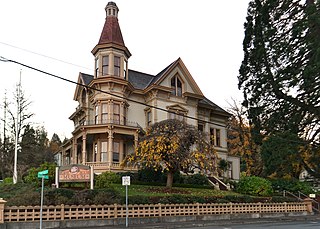
The Captain George Flavel House Museum known also as Capt. George Flavel House and Carriage House or the Flavel Mansion, is now a house museum in Astoria, Oregon, United States. It was built in 1885 in the Queen Anne architectural style, by George Flavel, a Columbia River bar pilot who was one of the area's first millionaires.

The United States Post Office in Astoria, Oregon, United States, is a historic building constructed in 1933. It is a two-story building on a raised basement. Its exterior dimensions are 79 by 137 feet. Its 11-bay front facade is divided by flat fluted pilasters with Corinthian capitals supporting a full entablature, with a balustraded parapet above, and a red-tiled hipped roof rising behind that. Its foundations had to be blasted by dynamite.
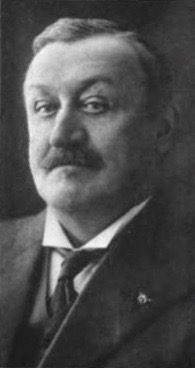
Emil Schacht was a prominent architect in Portland, Oregon. Schacht's work was prolific from the 1890s until World War I and he produced commercial buildings including factories and warehouses as well as residential projects, hotels and theatres. He is known for his craftsman architecture style homes and was a founding member of the 1902 Portland Association of architects.

The John Jacob Astor Hotel, originally known as the Hotel Astoria, is a historic former hotel building located in Astoria, Oregon, United States, and listed on the National Register of Historic Places (NRHP). It is one of the tallest buildings on the Oregon Coast and is a "prominent landmark" in Astoria. Constructed in 1922–23, the hotel opened in 1924 and initially was the city's social and business hub, but soon was beset with a variety of problems, and struggled financially for years. It was renamed the John Jacob Astor Hotel in 1951, but a decline in business continued, as did other problems. The building was condemned by the city for safety violations in 1968 and sat vacant for several years until 1984, when work to renovate it and convert it for apartments began. It reopened as an apartment building in 1986, with the lowermost two floors reserved for commercial use. The building was listed on the NRHP in 1979. The world's first cable television system was set up in 1948 using an antenna on the roof of the Hotel Astoria.

The Old Astoria City Hall, now known as the Clatsop County Historical Society Heritage Museum, is a historic building located in Astoria, Oregon, United States, that is listed on the National Register of Historic Places. The building served as the city hall of Astoria from 1905 until 1939. It was the first location of the Columbia River Maritime Museum, from 1963 to 1982, and has been the Heritage Museum since 1985.

The Astoria Victory Monument, also known as the Doughboy Monument or Soldiers' Monument, is a monument located in Astoria, Oregon, in the United States. It is listed on the National Register of Historic Places. The concrete, Spanish Revival monument designed by Charles T. Diamond was constructed in 1926, incorporating a cast of a sculpture by John Paulding. The structure was recognized individually by the National Register of Historic Places in 1984 and as part of the Uniontown–Alameda Historic District in 1988.

The Clatsop County Courthouse is a historic courthouse in Astoria, Clatsop County, Oregon, United States.

The Albert W. Ferguson House is a house located in Astoria, Oregon, listed on the National Register of Historic Places.

Union Fishermen's Cooperative Packing Company Alderbrook Station, on the Columbia River in Astoria, Oregon, was built in 1903. It was listed on the National Register of Historic Places (NRHP) in 1991. The listing included three contributing buildings and another contributing structure on a 4.5-acre (1.8 ha) area.
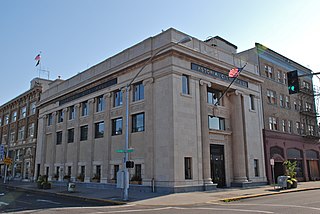
Astoria City Hall is the current city hall for the town of Astoria, Oregon, United States. Built in 1923 to house a bank, the building became the city hall in 1939, and it has remained Astoria's seat of government for more than 75 years.
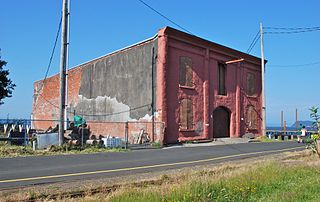
The Astoria Wharf and Warehouse Company building is a historic warehouse located in Astoria, Oregon, United States.
The Marshall J. Kinney Cannery, located in Uniontown, Astoria, Oregon, United States, between Fifth and Seventh streets, was constructed in 1879 and became one of the city's longest-running salmon canneries. Run by the Astoria Packing Company, of which Marshall J. Kinney was president, the complex quickly became the "largest and most extensive salmon-packing establishment on the Pacific Coast". In 1894, the cannery was completely rebuilt after being burned to the ground. Five years later Kinney became part of the Columbia River Packers Association, joining several other canneries and packing companies. By 1904, the complex supported three production lines; Kinney continued cannery operations until the 1920s when it was primarily used as a central machine shop and warehouse for the Columbia River Packers Association. In 1954, a cargo ship ran into the complex, part of which was lost. Intact portions were used for storage until 1980 and today house shops and small businesses. The cannery was added to the National Register of Historic Places on June 30, 1989, but was delisted on September 8, 1997.

Captain George Edward Flavel was an Irish American maritime pilot and entrepreneur. Born in 1823 to Irish parents, Flavel relocated to the West coast of the United States in 1849, working as a tugboat operator between Sacramento and San Francisco, California. In 1851, he settled in the northern coastal port city of Astoria, Oregon, where he became one of the first licensed bar pilots in the state.

The postal history of Oregon began in 1847, a year before the Oregon Territory was established, when the United States Post Office contracted delivery of postal items from the east coast of the United States to west coast locations via Panama. Post offices in Astoria and Oregon City were authorized. These were the first offices authorized west of the Rocky Mountains. It was not until 1849 that the Pacific Mail Steamship Company opened routes from Panama along the west coast. The earliest postmarked items from the offices in Astoria and Oregon City were in 1849. There is a significant amount of philatelic information published about Oregon. Oregon Post Offices by Richard W. Helbock provides a list of post offices. Charles A. Whittlesey and Richard W. Helbock have also written Oregon Postmarks, a catalog of postmarks through the 1800s. There is also A Checklist Of Oregon Post Offices, 1847-1988 by Helbock. This text provides a more condensed guide to the post offices. The current post office building in Astoria is listed in the National Register of Historic Places.

The Liberty Theater is a historic vaudeville theater and cinema in Astoria, Oregon, United States. The whole commercial building of which the theater is the major occupant is also known as the Astor Building, especially in the context of historic preservation.

